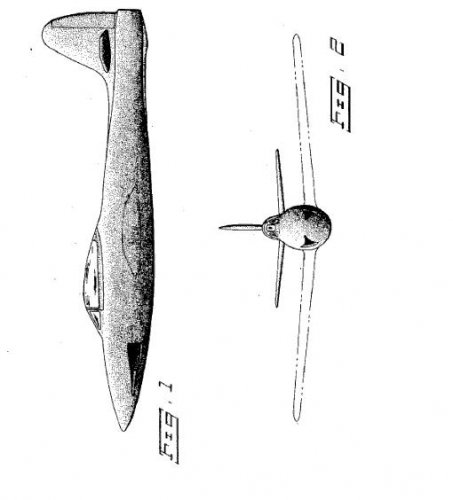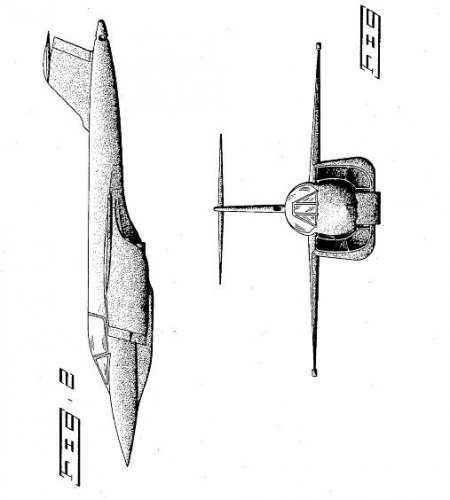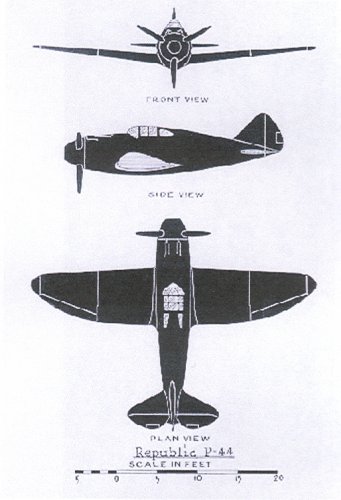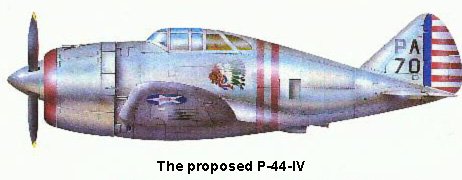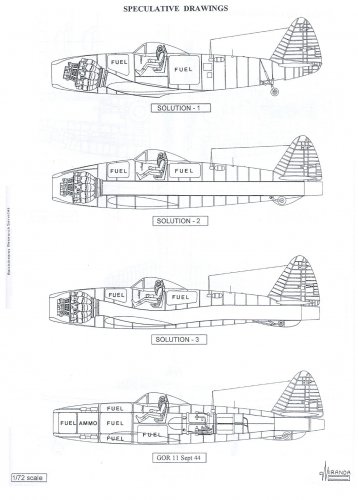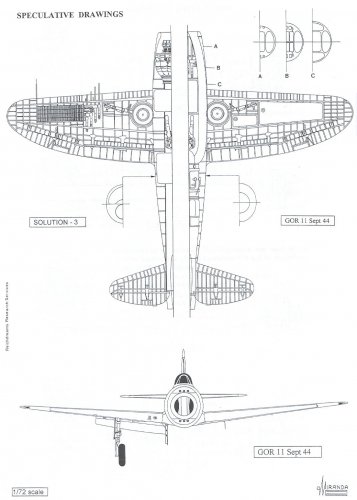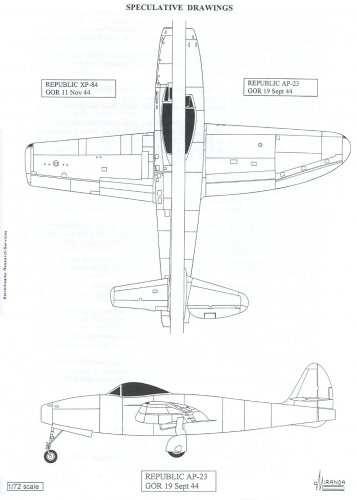You are using an out of date browser. It may not display this or other websites correctly.
You should upgrade or use an alternative browser.
You should upgrade or use an alternative browser.
Seversky/Republic AP series - AP-1 to AP-100
- Thread starter lark
- Start date
- Joined
- 26 May 2011
- Messages
- 2,317
- Reaction score
- 3,468
Check here:
for a photo of the PB2A Stratosphere Fighter. The name suggests high altitude performance, but did it have a pressurised cockpit, long wings and super / turbo charging? Only one of these visible in the photo appears to be the latter if the faired in exhaust fed a turbosupercharger.
I find no mention of it in Angelucci and Bowers, so if anyone has any additinal info I'd be interested.
Thanks
KB
for a photo of the PB2A Stratosphere Fighter. The name suggests high altitude performance, but did it have a pressurised cockpit, long wings and super / turbo charging? Only one of these visible in the photo appears to be the latter if the faired in exhaust fed a turbosupercharger.
I find no mention of it in Angelucci and Bowers, so if anyone has any additinal info I'd be interested.
Thanks
KB
- Joined
- 22 January 2006
- Messages
- 4,208
- Reaction score
- 2,001
The PB2A it is not a Republic product. This is why you can find any entry at Angelucci and Bowers. It is a Consolidated design. Look at pg 96 for it.
Originally designated P-30 by USAAC and renamed PB-2 from 1935.
Cheers
Antonio
Originally designated P-30 by USAAC and renamed PB-2 from 1935.
Cheers
Antonio
- Joined
- 26 May 2006
- Messages
- 34,832
- Reaction score
- 15,713
Hi,
I don't know the Republic AP designations to this two projects,but
I will tell a little about them;
The Republic Landbee was similar to the RC-3 as a land plane without
the sea hull and the Republic Beebee was two seat trainer powered
by one 100 hp engine.
I don't know the Republic AP designations to this two projects,but
I will tell a little about them;
The Republic Landbee was similar to the RC-3 as a land plane without
the sea hull and the Republic Beebee was two seat trainer powered
by one 100 hp engine.
Last edited:
- Joined
- 27 December 2005
- Messages
- 17,713
- Reaction score
- 26,188
AP-5 Single seat fighter.
AP-6 Single seat fighter.
AP-19 = XP-72.
AP-21a Appears to be North American XT-28.
AP.60 Four engine turboprop aircraft – probably transport. 1949.
From Tony Buttler
Hi overscan!
AP-5 Single seat fighter, and how many engines ?
AP-6 Single seat fighter, and how many engines ?
AP-21 a Appears to be North American XT-28, and purpose ?
AP-60 Four engine turboprop aircraft – probably transport (or probably bomber) ?
Whether can show pictures ?
AP-5 Single seat fighter, and how many engines ?
AP-6 Single seat fighter, and how many engines ?
AP-21 a Appears to be North American XT-28, and purpose ?
AP-60 Four engine turboprop aircraft – probably transport (or probably bomber) ?
Whether can show pictures ?
Reading 'Republics Battle Hymn' by Warren M.Bodie in
an old Wings & Airpower magazine (thanks Pometabla)
I came to this :
... a never before published photograph of the Republic P-44 IV mock-up....
... it appears that the mock-up used a company designation of AP-43
but that the production version was to be AP-4L...
(one day the list will be complete )
an old Wings & Airpower magazine (thanks Pometabla)
I came to this :
... a never before published photograph of the Republic P-44 IV mock-up....
... it appears that the mock-up used a company designation of AP-43
but that the production version was to be AP-4L...
(one day the list will be complete )
- Joined
- 25 July 2007
- Messages
- 4,299
- Reaction score
- 4,192
Re: Republic P-44
Many thanks for info and nice profile!
Many thanks for info and nice profile!
- Joined
- 22 January 2006
- Messages
- 4,208
- Reaction score
- 2,001
Re: Republic P-44
Apophenia,
I've been reading that link and I understand the R-2600 was the initial engine selected for the AP-4C but later replaced with the R-2800. An that's the engine shown in the drawing. What do you think?
Apophenia,
I've been reading that link and I understand the R-2600 was the initial engine selected for the AP-4C but later replaced with the R-2800. An that's the engine shown in the drawing. What do you think?
This new engine, powering Vought’s XF4U-1 to over 400 mph, was quickly selected for the AP-4C or P-44-IV.
- Joined
- 25 July 2007
- Messages
- 4,299
- Reaction score
- 4,192
Re: Republic P-44
Yes, I think you are quite right Antonio. The R-2800 also explains that very XP-47J-looking cowling.
Added:
overscan quoted Tony Buttler saying:
"AP-4L Proposal with 2000hp R-2800-7-also not constructed. Some sources use the name "Warrior" instead of "Rocket"."
So did the re-engined AP-4C / P-44-IV become the R-2800-powered AP-4L?
Yes, I think you are quite right Antonio. The R-2800 also explains that very XP-47J-looking cowling.
Added:
overscan quoted Tony Buttler saying:
"AP-4L Proposal with 2000hp R-2800-7-also not constructed. Some sources use the name "Warrior" instead of "Rocket"."
So did the re-engined AP-4C / P-44-IV become the R-2800-powered AP-4L?
- Joined
- 22 January 2006
- Messages
- 4,208
- Reaction score
- 2,001
So did the re-engined AP-4C / P-44-IV become the R-2800-powered AP-4L?
I'm a bit confused about AP-4 family:
According to Tony Buttler:
AP-4 Adaption of P-35. Order of 13 aircraft in March 1939 (YP-43) delivered in September 1940 as P-43 Lancer.
AP-4J 1400hp Pratt & Whitney R-2180-1 powered proposal. 80 ordered Sept 13, 1939 as P-44 Rocket. Order cancelled.
AP-4L Proposal with 2000hp R-2800-7-also not constructed. Some sources use the name "Warrior" instead of "Rocket".
According to http://home.att.net/~C.C.Jordan/index.html:
AP-4 same as Tony Buttler
AP-4B the design was to incorporate the R-2180 engine and the early design sketches reflect this engine. When that engine failed to live up to its promise, Republic selected the Wright R-2600.
AP-4C Unfortunately, as Grumman was to later discover, the R-2600 did not respond well to turbocharging. Luckily for Republic, before actual engineering drawings were laid down, the newly developed Pratt & Whitney R-2800 engine became available. This new engine, powering Vought’s XF4U-1 to over 400 mph, was quickly selected for the AP-4C or P-44-IV. Republic received a preliminary order for 80 of the aircraft
Who's right? ???
- Joined
- 22 January 2006
- Messages
- 4,208
- Reaction score
- 2,001
I've just located more info at Wings June 1994 issue "The origins of the P-47 Thunderbolt" by Warren M. Bodie. The text is coincident with Tony Buttler about AP-4L.
Republic P-44-IV mockup with XR-2800 engine. Plans existed to use a R-2800-11 unit. It appears that the mockup used a company designation of AP-43, but the production version was to be the AP-4L. 80 airplanes ordered on Contract W535 ac-13380. The contract was later cancelled except for two wind tunnel models.
Apophenia,
at least we know for sure that:
AP-4 was the P-43 designation (R-1830 engine)
P-44-IV powerplant was the R-2800
AP-4L was Republic's designation for the production P-44 (R-2800 engine)
the following identities still remain unclear (at least for me): AP-4B, AP-4C and AP-4J.
Keep on searching
Antonio
Republic P-44-IV mockup with XR-2800 engine. Plans existed to use a R-2800-11 unit. It appears that the mockup used a company designation of AP-43, but the production version was to be the AP-4L. 80 airplanes ordered on Contract W535 ac-13380. The contract was later cancelled except for two wind tunnel models.
Apophenia,
at least we know for sure that:
AP-4 was the P-43 designation (R-1830 engine)
P-44-IV powerplant was the R-2800
AP-4L was Republic's designation for the production P-44 (R-2800 engine)
the following identities still remain unclear (at least for me): AP-4B, AP-4C and AP-4J.
Keep on searching
Antonio
Kim Margosein
ACCESS: Confidential
- Joined
- 9 February 2007
- Messages
- 101
- Reaction score
- 13
P-47 to P-84
I would buy several also if it was easier. I know, you have explained why this does not work, and I understand. As one who discovered your work in Antarctic Press, any chance of showing what you have on the P-47 to F-84 evolution?
A Colonel Condorcet fan.
Kim M
I would buy several also if it was easier. I know, you have explained why this does not work, and I understand. As one who discovered your work in Antarctic Press, any chance of showing what you have on the P-47 to F-84 evolution?
A Colonel Condorcet fan.
Kim M
- Joined
- 22 January 2006
- Messages
- 4,208
- Reaction score
- 2,001
P-47 to P-84
Kim, to avoid off-topic please take a look here to ask for P-47 to P-84 evolution
And, possibly the best place to keep information organized, should be here:
Thanks in advance
Kim, to avoid off-topic please take a look here to ask for P-47 to P-84 evolution
And, possibly the best place to keep information organized, should be here:
Thanks in advance
Last edited by a moderator:
Re: CAC CA-15 original design
From UNKNOWN! N.3
JET THUNDERBOLT
By mid 1943 the US Army Air Force decided to order the design and construction of the first American air superiority jet fighter to Lockheed company.
The new fighter, named XP-80 under the GOR specification of 23rd June 1943, was flying by the beginning of 1944, being the first American airplane to surpass the 500 m.p.h.
The Republic XP-72, designed to succeed the Thunderbolt, flew for the first time one month later. It was an impressive machine able to fly at 490 m.p.h. propelled by the most powerful piston engine developed during the WWII.
However, the US Army Air Force rejected the project as it was considered obsolete compared to the XP-80 of which 4390 units were ordered on 1st July 1944.
The reason behind the technological delay of the Republic was the consequence of its previous success in the manufacturing of the Thundertbolt, the American fighter produced in highest number during the WWII.
The US Army Force did not wish any delay in the delivery program of the P-47. They adviced against any important modification of the basic model that could alter the production rate.
This policy prevented Republic designing a totally new jet fighter. However, some studies were made in 1943 over the possible adaptation of a De Havilland centrifugal turbojet (the only model available at the time) to the airframe of a P-47 or an XP-72.
There are no documents left on that study, although it must be stressed that there are not many different ways to install the engine without a whole redesigning of the airplane.
We propose below three reasonable possibilities:
SOLUTION 1
It required a minimum of modifications in the airframe. This disposition was used by the Soviets for their first generation of jet fighters Yak-15 and Lavochkin-174 and by the Italians for the building of the supersonic airplane Aerfer "Sagittario 2"
The main problems generated by the position of the jet exhaust were the possibility of a fire to the rear fuselage during take-off (the Russians used metallic tailwheels) and certain reduction in the longitudinal rate of roll.
SOLUTION 2
The fuselage and jet exhaust axis were made to coincide with each other, but it required to make extensive modifications in the upper part of the fuselage raising it in the 'Hellcat style'.
SOLUTION 3
It removed this last problem using an "S" shaped jet exhaust which excessive length affected in a negative way the power of the turbojet and the amount of fuel internally transported.
During July 1944 an unprecedented change took place in the war. The British Gloster Meteor Mk.I (410 m.p.h.) went into service just in time to intercept the first V-1 flying bombs which were projected to reach the 559 m.p.h. but with a maximum real speed of just 408 m.p.h. due to the aerodynamic deficiencies caused by the rough German system of mass production.
The first sightings of the Me 262 (540 m.p.h.) and Me 163 (596 m.p.h.) also happened at that time.
On 4th August the XP-47 J, a lighter version of the Thunderbolt, reached the speed record for airplanes with propellers, flying at 504 m.p.h. But it was not enough to face the new swept wing German designs.
The whole production of centrifugal turbojets was reserved for the Lockheed P-80.
The first flight of the P-47 N, the long range version, was made in September, designed to fight in the Pacific Theatre escorting the B-29 bombers.
No jet fighter could perform this task due to the enormous fuel comsumption made by the first centrifugal turbojets engines which great volume used the whole interior of the P-80 fuselage.
A two-engined formula was tried with the Bell XP-83 (an extended version of the P-59) resulting in a huge and heavy airplane unable to manoeuvre to face the Japanese Shusui and Kikka jet and rocket fighters.
The US Army Air Force reached the conclusion that a new technical miracle was needed to achieve the required high speed and range (mutally exclusive conditions) similar to the one obtained in Europe with the P-47 in 1943.
In May 1944 the Alexander Kartveli team of the Republic company was instructed to design an aircraft around the new General Electric TG-180 axial-flow turbojet.
It was expected that the small diameter of the new engine would leave enough room in the fuselage to transport a big fuel load.
The TG-180 was tested for the first time in April 1944 with great success showing a thrust of 3750 lb (1700 kgp) and a lower compsuntion than the centrifugal engines. It had a diameter of 37.5 inch (45 cm), 12 ft (366 cm) of length and 2500 lb (1132 kg) of weight.
The Air Force General Operational Requirement (GOR), officially published on 11 September 1944, required the design of a mid-wing fighter with a top speed of 600 m.p.h. and combat radius of 850 miles.
The armament should be eight .50 (12.7 mm) calibre M2 machine guns or six .60 of the experimental type.
The TG-180 was too long to locate it at the nose of the airplane. It should be installed in the fuselage behind the pilot. The air-intake located in the nose went through under the cockpit. The new disposition created enormous problems of stability in an airframe designed to carry a heavy engine in the forward area.
Between May and September 1944 the Republic project staff studied the possibility of redistributing the weight by installing the fuel, ammunition and armament in the nose and the air duct being forked in two going through both sides of the cockpit and joining behind it once more. The wings also housed fuel in the weapons previous location.
An insoluble problem appeared when the airplane shot its weapons after having wasted half its fuel. It started to be heavier in the tail and difficult to control during the return flight and landing.
On 19th September the idea of reconverting the P-47 was abandoned opting for a new design named AP-23. The position of the wing was taken 72 cm backwards, the cockpit was put 140 cm forward,a new tricycle type landing gear was installed.
The installation of the nosewheel just allowed an armament of four machine guns in the upper nose. The GOR was modified by beginning of November to transport just six weapons, the other two were installed in the wingroots.
The combat radius was also reduced to 705 miles, abandoning the idea of "long range" in favour of the "penetration fighter" concept, adapted to the new strategy used in the war against Japan where air bases nearer the metropoli were at hand.
On 11 November 1944 the US Army Air Force accepted the new design under the denomination XP-84 fitted with a new rectangular thicker wing specially designed to contain fuel. The building of prototypes was then authorised with the first flight of the new airplane taking place on 28th February 1946.
Bibliography
• Aeroplane Monthly December 1976
• "The Thunder Factory" by Joshua Stoff, ARMS & ARMOUR
• "F-84 Thunderjet in action", Squadron Signal No. 61
• "Republic F-84" by David R. McLaren, Schiffer 1998
• "F-84 Thunderjet" by Bert Kinzey (In detail Vol 59) Squadron Signal 1999
• "Le Fanatique de l'Aviation" Hors Série No. 16, December 2001
• Correspondence with Chuck Davis
Kim Margosein said:I would buy several also if it was easier. I know, you have explained why this does not work, and I understand. As one who discovered your work in Antarctic Press, any chance of showing what you have on the P-47 to F-84 evolution?
A Colonel Condorcet fan.
Kim M
From UNKNOWN! N.3
JET THUNDERBOLT
By mid 1943 the US Army Air Force decided to order the design and construction of the first American air superiority jet fighter to Lockheed company.
The new fighter, named XP-80 under the GOR specification of 23rd June 1943, was flying by the beginning of 1944, being the first American airplane to surpass the 500 m.p.h.
The Republic XP-72, designed to succeed the Thunderbolt, flew for the first time one month later. It was an impressive machine able to fly at 490 m.p.h. propelled by the most powerful piston engine developed during the WWII.
However, the US Army Air Force rejected the project as it was considered obsolete compared to the XP-80 of which 4390 units were ordered on 1st July 1944.
The reason behind the technological delay of the Republic was the consequence of its previous success in the manufacturing of the Thundertbolt, the American fighter produced in highest number during the WWII.
The US Army Force did not wish any delay in the delivery program of the P-47. They adviced against any important modification of the basic model that could alter the production rate.
This policy prevented Republic designing a totally new jet fighter. However, some studies were made in 1943 over the possible adaptation of a De Havilland centrifugal turbojet (the only model available at the time) to the airframe of a P-47 or an XP-72.
There are no documents left on that study, although it must be stressed that there are not many different ways to install the engine without a whole redesigning of the airplane.
We propose below three reasonable possibilities:
SOLUTION 1
It required a minimum of modifications in the airframe. This disposition was used by the Soviets for their first generation of jet fighters Yak-15 and Lavochkin-174 and by the Italians for the building of the supersonic airplane Aerfer "Sagittario 2"
The main problems generated by the position of the jet exhaust were the possibility of a fire to the rear fuselage during take-off (the Russians used metallic tailwheels) and certain reduction in the longitudinal rate of roll.
SOLUTION 2
The fuselage and jet exhaust axis were made to coincide with each other, but it required to make extensive modifications in the upper part of the fuselage raising it in the 'Hellcat style'.
SOLUTION 3
It removed this last problem using an "S" shaped jet exhaust which excessive length affected in a negative way the power of the turbojet and the amount of fuel internally transported.
During July 1944 an unprecedented change took place in the war. The British Gloster Meteor Mk.I (410 m.p.h.) went into service just in time to intercept the first V-1 flying bombs which were projected to reach the 559 m.p.h. but with a maximum real speed of just 408 m.p.h. due to the aerodynamic deficiencies caused by the rough German system of mass production.
The first sightings of the Me 262 (540 m.p.h.) and Me 163 (596 m.p.h.) also happened at that time.
On 4th August the XP-47 J, a lighter version of the Thunderbolt, reached the speed record for airplanes with propellers, flying at 504 m.p.h. But it was not enough to face the new swept wing German designs.
The whole production of centrifugal turbojets was reserved for the Lockheed P-80.
The first flight of the P-47 N, the long range version, was made in September, designed to fight in the Pacific Theatre escorting the B-29 bombers.
No jet fighter could perform this task due to the enormous fuel comsumption made by the first centrifugal turbojets engines which great volume used the whole interior of the P-80 fuselage.
A two-engined formula was tried with the Bell XP-83 (an extended version of the P-59) resulting in a huge and heavy airplane unable to manoeuvre to face the Japanese Shusui and Kikka jet and rocket fighters.
The US Army Air Force reached the conclusion that a new technical miracle was needed to achieve the required high speed and range (mutally exclusive conditions) similar to the one obtained in Europe with the P-47 in 1943.
In May 1944 the Alexander Kartveli team of the Republic company was instructed to design an aircraft around the new General Electric TG-180 axial-flow turbojet.
It was expected that the small diameter of the new engine would leave enough room in the fuselage to transport a big fuel load.
The TG-180 was tested for the first time in April 1944 with great success showing a thrust of 3750 lb (1700 kgp) and a lower compsuntion than the centrifugal engines. It had a diameter of 37.5 inch (45 cm), 12 ft (366 cm) of length and 2500 lb (1132 kg) of weight.
The Air Force General Operational Requirement (GOR), officially published on 11 September 1944, required the design of a mid-wing fighter with a top speed of 600 m.p.h. and combat radius of 850 miles.
The armament should be eight .50 (12.7 mm) calibre M2 machine guns or six .60 of the experimental type.
The TG-180 was too long to locate it at the nose of the airplane. It should be installed in the fuselage behind the pilot. The air-intake located in the nose went through under the cockpit. The new disposition created enormous problems of stability in an airframe designed to carry a heavy engine in the forward area.
Between May and September 1944 the Republic project staff studied the possibility of redistributing the weight by installing the fuel, ammunition and armament in the nose and the air duct being forked in two going through both sides of the cockpit and joining behind it once more. The wings also housed fuel in the weapons previous location.
An insoluble problem appeared when the airplane shot its weapons after having wasted half its fuel. It started to be heavier in the tail and difficult to control during the return flight and landing.
On 19th September the idea of reconverting the P-47 was abandoned opting for a new design named AP-23. The position of the wing was taken 72 cm backwards, the cockpit was put 140 cm forward,a new tricycle type landing gear was installed.
The installation of the nosewheel just allowed an armament of four machine guns in the upper nose. The GOR was modified by beginning of November to transport just six weapons, the other two were installed in the wingroots.
The combat radius was also reduced to 705 miles, abandoning the idea of "long range" in favour of the "penetration fighter" concept, adapted to the new strategy used in the war against Japan where air bases nearer the metropoli were at hand.
On 11 November 1944 the US Army Air Force accepted the new design under the denomination XP-84 fitted with a new rectangular thicker wing specially designed to contain fuel. The building of prototypes was then authorised with the first flight of the new airplane taking place on 28th February 1946.
Bibliography
• Aeroplane Monthly December 1976
• "The Thunder Factory" by Joshua Stoff, ARMS & ARMOUR
• "F-84 Thunderjet in action", Squadron Signal No. 61
• "Republic F-84" by David R. McLaren, Schiffer 1998
• "F-84 Thunderjet" by Bert Kinzey (In detail Vol 59) Squadron Signal 1999
• "Le Fanatique de l'Aviation" Hors Série No. 16, December 2001
• Correspondence with Chuck Davis
Attachments
Kim Margosein
ACCESS: Confidential
- Joined
- 9 February 2007
- Messages
- 101
- Reaction score
- 13
Re: CAC CA-15 original design
Thanks, Justo. This is exactly what I was looking for.
Kim M
Thanks, Justo. This is exactly what I was looking for.
Kim M
Hi overscan!
AP-5 Single seat fighter.
AP-6 Single seat fighter.
AP-19 = XP-72.
AP-21a Appears to be North American XT-28.
AP.60 Four engine turboprop aircraft – probably transport. 1949.
Whether can name a source?
If you can.
AP-5 Single seat fighter.
AP-6 Single seat fighter.
AP-19 = XP-72.
AP-21a Appears to be North American XT-28.
AP.60 Four engine turboprop aircraft – probably transport. 1949.
Whether can name a source?
If you can.
- Joined
- 25 June 2009
- Messages
- 14,735
- Reaction score
- 6,079
I realize your list is missing AP-76, which was Republic's proposal against the North American NA-240 (which won and became the X-15).
As for the AP-4 versions, here's what I have:
AP-4 -- Adaptation of P-35, one prototype [NX2597]. Procured as P-43 series.
AP-4 -- Production version of AP-4 prototype delivered in September 1940 as YP-43 "LANCER". Also P-43, XP-43, (R)P-43A, P-43A/B/C/D/E
AP-4J -- version with a 400 hp Pratt &Whitney R-2180-1; 80 ordered in Sept 13,1939 as the P-44-1 "ROCKET"; cancelled and transfered to P-43
AP-4L -- version with 2000 hp R-2800-7; 200 ordered as the P-44-2 "WARRIOR", also cancelled, and transfered to P-47B/C
(Main source: United States Army and Air Force Fighters 1916-1961, Harleyford, 1961)
I must say I do not know where the AP-4B and -4C fit in here...
Finally, the P-35 is complicated too...
- It appears that it received the designation AP-1 (for Army Pursuit)
- The proposed naval version was the NF-1 (for Naval Fighter, as the Navy called them so) [X1254]
- Naval Aircraft Factory developed a derivative prototype as the XFN-1 (for Experimental Fighter, NAF, Type 1)!
- The demonstrator for export versions were quite logically designated EP-1 (for Export Pursuit) [NX2587]
- The version for Sweden was the EP-1-106 "GUARDSMAN" (sometimes found as EP-106)
- These were diverted to USAAC and became the P-35A, later RP-35A, but remained EP-106.
- The civilian version of the P-35 was called the DS or DS-1 "EXECUTIVE"
- The last P-35 was modified as the XP-41 (a modified P-35 with new streamlined canopy, a Wright R-1830-19 engine with a two-speed supercharger, and revised landing gear), which appears in many sources as the AP-2
- However, many sources also give the designation AP-2 for a civilian racer [R1250].
This is all very confusing, despite the numerous articles and books I have browsed through on the subject over the years!
As for the AP-4 versions, here's what I have:
AP-4 -- Adaptation of P-35, one prototype [NX2597]. Procured as P-43 series.
AP-4 -- Production version of AP-4 prototype delivered in September 1940 as YP-43 "LANCER". Also P-43, XP-43, (R)P-43A, P-43A/B/C/D/E
AP-4J -- version with a 400 hp Pratt &Whitney R-2180-1; 80 ordered in Sept 13,1939 as the P-44-1 "ROCKET"; cancelled and transfered to P-43
AP-4L -- version with 2000 hp R-2800-7; 200 ordered as the P-44-2 "WARRIOR", also cancelled, and transfered to P-47B/C
(Main source: United States Army and Air Force Fighters 1916-1961, Harleyford, 1961)
I must say I do not know where the AP-4B and -4C fit in here...
Finally, the P-35 is complicated too...
- It appears that it received the designation AP-1 (for Army Pursuit)
- The proposed naval version was the NF-1 (for Naval Fighter, as the Navy called them so) [X1254]
- Naval Aircraft Factory developed a derivative prototype as the XFN-1 (for Experimental Fighter, NAF, Type 1)!
- The demonstrator for export versions were quite logically designated EP-1 (for Export Pursuit) [NX2587]
- The version for Sweden was the EP-1-106 "GUARDSMAN" (sometimes found as EP-106)
- These were diverted to USAAC and became the P-35A, later RP-35A, but remained EP-106.
- The civilian version of the P-35 was called the DS or DS-1 "EXECUTIVE"
- The last P-35 was modified as the XP-41 (a modified P-35 with new streamlined canopy, a Wright R-1830-19 engine with a two-speed supercharger, and revised landing gear), which appears in many sources as the AP-2
- However, many sources also give the designation AP-2 for a civilian racer [R1250].
This is all very confusing, despite the numerous articles and books I have browsed through on the subject over the years!
- Joined
- 25 June 2009
- Messages
- 14,735
- Reaction score
- 6,079
Just found something while digging through tons of web noise...
AP-16a -- P-47M THUNDERBOLT
Source: http://www.ww2aircraft.net/forum/aviation/ta152h1-high-altitude-speed-16103.html
AP-16a -- P-47M THUNDERBOLT
Source: http://www.ww2aircraft.net/forum/aviation/ta152h1-high-altitude-speed-16103.html
- Joined
- 25 June 2009
- Messages
- 14,735
- Reaction score
- 6,079
Here's a recapitulation of the designations quoted so far (I believe this is as complete as it gets, but I hope some of you prove me wrong!):
AP-1 P-35; also modified P-35 for trials [NR1390]
EP-1 GUARDSMAN. Export version of P-35 (EP-1 for export pursuit); diverted to USAAC as the P-43A.
AP-2 Racer [R1250]; proposed as pursuit with flush, rectracting gear, lost
AP-2 XP-41; a P-35 modified with new streamlined canopy, a Wright R-1830-19 engine with a two-speed supercharger, and revised landing gear
AP-3 pursuit proposal, an unbuilt P-35 version with liquid cooled Allison V-1710 engine, abandoned in favour of AP-4
AP-4 LANCER. Adaptation of P-35 [NX2597]. Procured as P-43 series.
AP-4(A) LANCER. Production version of AP-4 prototype delivered in September 1940 as YP-43. Also P-43, XP-43, (R)P-43A, P-43A/B/C/D/E
AP-4J ROCKET (P-44-1) proposal. 400 hp Pratt &Whitney R-2180-1; 80 ordered in Sept 13,1939 as the P-44; cancelled and transfered to P-43
AP-4B XP-44 project; cancelled
AP-4C P-44-IV project with R-2600 engine; mockup with XR-2800; not built
AP-4L WARRIOR (P-44-2) proposal with 2000Hp R-2800-7; 200 ordered, also cancelled, and transfered to P-47B/C
AP-5 Single-seat fighter project; appears in the Sarah Clark collection
AP-6/A Single-seat fighter project; appears in the Sarah Clark collection
AP-7/A Speed record aircraft used by Major de Seversky to establish a new transcontinental speed record [NX1384]
AP-8 Fighter proposal; never completed; formed the basis for the AP-9
AP-9 Entrant in the 1939 Air Corps fighter competition, based on AP-8, used improved airfoil; lost to XP-39 [NX2598]
AP-10 THUNDERBOLT. Response to AC CP 39-770; light weight fighter to be powered by Allison V-1710 liquid cooled engine; ordered as XP-47
AP-11
AP-12 ROCKET. R-40C specification; highly streamlined design, engine behind the cockpit, driving tractor contraprop in nose via long shaft
AP-13
AP-14
AP-15
AP-16a THUNDERBOLT. P-47M.
AP-17
AP-18 Development of AP-12; intended powerplant Wright R-2160; ordered as the XP-69 in July 1941; scale mock-up June 1942, cancelled 1943
AP-19 XP-72
AP-20
AP-21a Seems to be North American's XT-28 (probably subcontracted); appears in the Sara Clark collection
AP-22
AP-23 THUNDERJET. Initial design for what became the XP-84; on 11 November 1944, three XP-84 were ordered
AP-23F THUNDERJET. F-84C variant.
AP-23X Preliminary design for a sweptwing F-84 (March 1947); not accepted by the Air Force Material Command
AP-23M THUNDERSTREAK. Final swept wing proposal; ordered as the YF-96 on n the November 10, 1949
AP-24 appears in the Sarah Clark collection
AP-25
AP-26
AP-27
AP-28
AP-29
AP-30
AP-31 Proposal for high performance research aircraft and day interceptor, ordered as the XP-91. Became the XF-91 after redesign.
AP-31-N1 THUNDERCEPTOR.
AP-32
AP-33
AP-34
AP-35
AP-36
AP-37
AP-38
AP-39
AP-40
AP-41
AP-42 Large USAF swept wing jet bomber project
AP-43
AP-44A Mach 3 all-weather high altitude interceptor (led to AP-57)
AP-45
AP-46 THUNDERSCREECH. Development of F-84F fitted with turboprop engine as XF-84H and first flown 22.7.55. No production.
AP-47
NP-48 Proposal to the U.S.Navy closely resembling the XP-91, with butterfly tail, wing with inverse taper but without wing tanks / rocket engines
NP-49 Proposal to the U.S.Navy, same tail and wing arrangement as NP-48 but with two engines below the wing; nose partly glazed
NP-50 US Navy bomber project similar in configuration to the Skywarrior
AP-51
NP-52 Twin-engine anti-submarine aircraft
AP-53
AP-54 Single engine swept wing all-weather interceptor fighter study with F-91-style wing and large tip fittings
AP-55 Twin-boom inverted V-tail lightweight fighter/interceptor project (F-91 derivative) against F-104. Several versions drawn, none built.
AP-56
AP-57 ‘1954 Interceptor’ proposal and full development into Mach 3 XF-103. 3 prototypes ordered, cancelled Aug. 1957
AP-58
AP-59
AP-60 Four-engine turboprop aircraft – probably transport; appears in the Sara Clark collection
AP-61
AP-62
AP-63 THUNDERCHIEF. Swept wing fighter bomber. Numerous layouts covered by designation. Eventually design AP-63-31 built as F-105A
AP-64
AP-65
AP-66
AP-67
AP-68
AP-69
AP-70
AP-71
AP-72
AP-73
AP-74
AP-75 Long range interceptor project to WS-202A
AP-76 project competing with North American X-15
AP-77
AP-78
AP-79
AP-80
AP-81
AP-82
AP-83
AP-84
AP-85 Two-seat swept-wing development of F-84F Thunderstreak.
AP-86
AP-87
AP-88
AP-89
AP-90
AP-91
AP-92
AP-93
AP-94
AP-95
AP-96
AP-97
AP-98
AP-99
AP-100 V/STOL fighter-bomber proposal with three large lift fans mounted in centre of wide fuselage
EP-1-106 GUARDSMAN. New designation of EP-1 in USAAC service (also found as DS-1 and AP-35!). Became RP-35A.
FR-150 SCS V/STOL fighter design proposed for Sea Control Ship. Lost competition to Rockwell XFV-12A.
FRC-225 Rutan 73 demonstrator; also proposed variant of T-46A and civil version?
FRC-226 sub-scale demonstrator of T-46A
D-24 Republic-Fokker ALLIANCE proposal (Fokker designation)
? THUNDERBUG or LOON, a copy of the Fieseler Fi.103 "V-1".
AP-1 P-35; also modified P-35 for trials [NR1390]
EP-1 GUARDSMAN. Export version of P-35 (EP-1 for export pursuit); diverted to USAAC as the P-43A.
AP-2 Racer [R1250]; proposed as pursuit with flush, rectracting gear, lost
AP-2 XP-41; a P-35 modified with new streamlined canopy, a Wright R-1830-19 engine with a two-speed supercharger, and revised landing gear
AP-3 pursuit proposal, an unbuilt P-35 version with liquid cooled Allison V-1710 engine, abandoned in favour of AP-4
AP-4 LANCER. Adaptation of P-35 [NX2597]. Procured as P-43 series.
AP-4(A) LANCER. Production version of AP-4 prototype delivered in September 1940 as YP-43. Also P-43, XP-43, (R)P-43A, P-43A/B/C/D/E
AP-4J ROCKET (P-44-1) proposal. 400 hp Pratt &Whitney R-2180-1; 80 ordered in Sept 13,1939 as the P-44; cancelled and transfered to P-43
AP-4B XP-44 project; cancelled
AP-4C P-44-IV project with R-2600 engine; mockup with XR-2800; not built
AP-4L WARRIOR (P-44-2) proposal with 2000Hp R-2800-7; 200 ordered, also cancelled, and transfered to P-47B/C
AP-5 Single-seat fighter project; appears in the Sarah Clark collection
AP-6/A Single-seat fighter project; appears in the Sarah Clark collection
AP-7/A Speed record aircraft used by Major de Seversky to establish a new transcontinental speed record [NX1384]
AP-8 Fighter proposal; never completed; formed the basis for the AP-9
AP-9 Entrant in the 1939 Air Corps fighter competition, based on AP-8, used improved airfoil; lost to XP-39 [NX2598]
AP-10 THUNDERBOLT. Response to AC CP 39-770; light weight fighter to be powered by Allison V-1710 liquid cooled engine; ordered as XP-47
AP-11
AP-12 ROCKET. R-40C specification; highly streamlined design, engine behind the cockpit, driving tractor contraprop in nose via long shaft
AP-13
AP-14
AP-15
AP-16a THUNDERBOLT. P-47M.
AP-17
AP-18 Development of AP-12; intended powerplant Wright R-2160; ordered as the XP-69 in July 1941; scale mock-up June 1942, cancelled 1943
AP-19 XP-72
AP-20
AP-21a Seems to be North American's XT-28 (probably subcontracted); appears in the Sara Clark collection
AP-22
AP-23 THUNDERJET. Initial design for what became the XP-84; on 11 November 1944, three XP-84 were ordered
AP-23F THUNDERJET. F-84C variant.
AP-23X Preliminary design for a sweptwing F-84 (March 1947); not accepted by the Air Force Material Command
AP-23M THUNDERSTREAK. Final swept wing proposal; ordered as the YF-96 on n the November 10, 1949
AP-24 appears in the Sarah Clark collection
AP-25
AP-26
AP-27
AP-28
AP-29
AP-30
AP-31 Proposal for high performance research aircraft and day interceptor, ordered as the XP-91. Became the XF-91 after redesign.
AP-31-N1 THUNDERCEPTOR.
AP-32
AP-33
AP-34
AP-35
AP-36
AP-37
AP-38
AP-39
AP-40
AP-41
AP-42 Large USAF swept wing jet bomber project
AP-43
AP-44A Mach 3 all-weather high altitude interceptor (led to AP-57)
AP-45
AP-46 THUNDERSCREECH. Development of F-84F fitted with turboprop engine as XF-84H and first flown 22.7.55. No production.
AP-47
NP-48 Proposal to the U.S.Navy closely resembling the XP-91, with butterfly tail, wing with inverse taper but without wing tanks / rocket engines
NP-49 Proposal to the U.S.Navy, same tail and wing arrangement as NP-48 but with two engines below the wing; nose partly glazed
NP-50 US Navy bomber project similar in configuration to the Skywarrior
AP-51
NP-52 Twin-engine anti-submarine aircraft
AP-53
AP-54 Single engine swept wing all-weather interceptor fighter study with F-91-style wing and large tip fittings
AP-55 Twin-boom inverted V-tail lightweight fighter/interceptor project (F-91 derivative) against F-104. Several versions drawn, none built.
AP-56
AP-57 ‘1954 Interceptor’ proposal and full development into Mach 3 XF-103. 3 prototypes ordered, cancelled Aug. 1957
AP-58
AP-59
AP-60 Four-engine turboprop aircraft – probably transport; appears in the Sara Clark collection
AP-61
AP-62
AP-63 THUNDERCHIEF. Swept wing fighter bomber. Numerous layouts covered by designation. Eventually design AP-63-31 built as F-105A
AP-64
AP-65
AP-66
AP-67
AP-68
AP-69
AP-70
AP-71
AP-72
AP-73
AP-74
AP-75 Long range interceptor project to WS-202A
AP-76 project competing with North American X-15
AP-77
AP-78
AP-79
AP-80
AP-81
AP-82
AP-83
AP-84
AP-85 Two-seat swept-wing development of F-84F Thunderstreak.
AP-86
AP-87
AP-88
AP-89
AP-90
AP-91
AP-92
AP-93
AP-94
AP-95
AP-96
AP-97
AP-98
AP-99
AP-100 V/STOL fighter-bomber proposal with three large lift fans mounted in centre of wide fuselage
EP-1-106 GUARDSMAN. New designation of EP-1 in USAAC service (also found as DS-1 and AP-35!). Became RP-35A.
FR-150 SCS V/STOL fighter design proposed for Sea Control Ship. Lost competition to Rockwell XFV-12A.
FRC-225 Rutan 73 demonstrator; also proposed variant of T-46A and civil version?
FRC-226 sub-scale demonstrator of T-46A
D-24 Republic-Fokker ALLIANCE proposal (Fokker designation)
? THUNDERBUG or LOON, a copy of the Fieseler Fi.103 "V-1".
My Friend Stargazer2006!
1) AP-30 Engineering designation for F-84?
AP-37 Engineering designation for F-84?
AP-38 Engineering designation for F-84?
2) FRC-225 Rutan 73 demonstrator; also proposed variant of T-46A and civil version?
FRC-226 sub-scale demonstrator of T-46A
3) FRC-160?A-10A THUNDERBOLT II (c/n numbers start with 160)
a source of informations ?
Forgive if you can indicate the source (I was at their of these sources will be researchers in their mind).
1) AP-30 Engineering designation for F-84?
AP-37 Engineering designation for F-84?
AP-38 Engineering designation for F-84?
2) FRC-225 Rutan 73 demonstrator; also proposed variant of T-46A and civil version?
FRC-226 sub-scale demonstrator of T-46A
3) FRC-160?A-10A THUNDERBOLT II (c/n numbers start with 160)
a source of informations ?
Forgive if you can indicate the source (I was at their of these sources will be researchers in their mind).
- Joined
- 25 June 2009
- Messages
- 14,735
- Reaction score
- 6,079
As I can't trace my sources right now, I prefer to remove the uncertain designations.
As for FRC-225 and FRC-226, I'm positive they appeared all over the place in the early 1980s. I'll try and find some sources soonest.
As for FRC-225 and FRC-226, I'm positive they appeared all over the place in the early 1980s. I'll try and find some sources soonest.
- Joined
- 27 December 2005
- Messages
- 17,713
- Reaction score
- 26,188
From Tony Buttler
New additions for the Republic Projects list.
Model AP-22 - Drone (apparently a version of the V-1 flying bomb).
AP-24 - Amphibious aircraft with XO-425-7 Franklin air-cooled engines, 1945.
AP-38 - Cargo and Personnel Land-based Transport.
AP-41 - The original proposal for the XF-12 Rainbow, drawing dated 15.10.47.
- Joined
- 25 June 2009
- Messages
- 14,735
- Reaction score
- 6,079
Model AP-22 - Drone (apparently a version of the V-1 flying bomb).
That would be the JB-2 THUNDERBUG, also known as the LOON.
AP-24 - Amphibious aircraft with XO-425-7 Franklin air-cooled engines, 1945.
That would be the RC-1 THUNDERBOLT AMPHIBIAN, the prototype of the RC-2/RC-3 SEABEE series.
Hi overscan!
New additions for the Republic Projects list.
Model AP-22 - Drone (apparently a version of the V-1 flying bomb).
AP-24 - Amphibious aircraft with XO-425-7 Franklin air-cooled engines, 1945.
AP-38 - Cargo and Personnel Land-based Transport.
AP-41 - The original proposal for the XF-12 Rainbow, drawing dated 15.10.47.
A source?
New additions for the Republic Projects list.
Model AP-22 - Drone (apparently a version of the V-1 flying bomb).
AP-24 - Amphibious aircraft with XO-425-7 Franklin air-cooled engines, 1945.
AP-38 - Cargo and Personnel Land-based Transport.
AP-41 - The original proposal for the XF-12 Rainbow, drawing dated 15.10.47.
A source?
Similar threads
-
-
-
RARE 16mm Films Republic Aviation AP-100 VTOL Fighter
- Started by Orionblamblam
- Replies: 8
-
CAB - Cantieri Aeronautici Bergamaschi, Caproni ...
- Started by Apophenia
- Replies: 11
-
AN/APS-20E Tri-Band radar
- Started by A_Random_Guy
- Replies: 0

